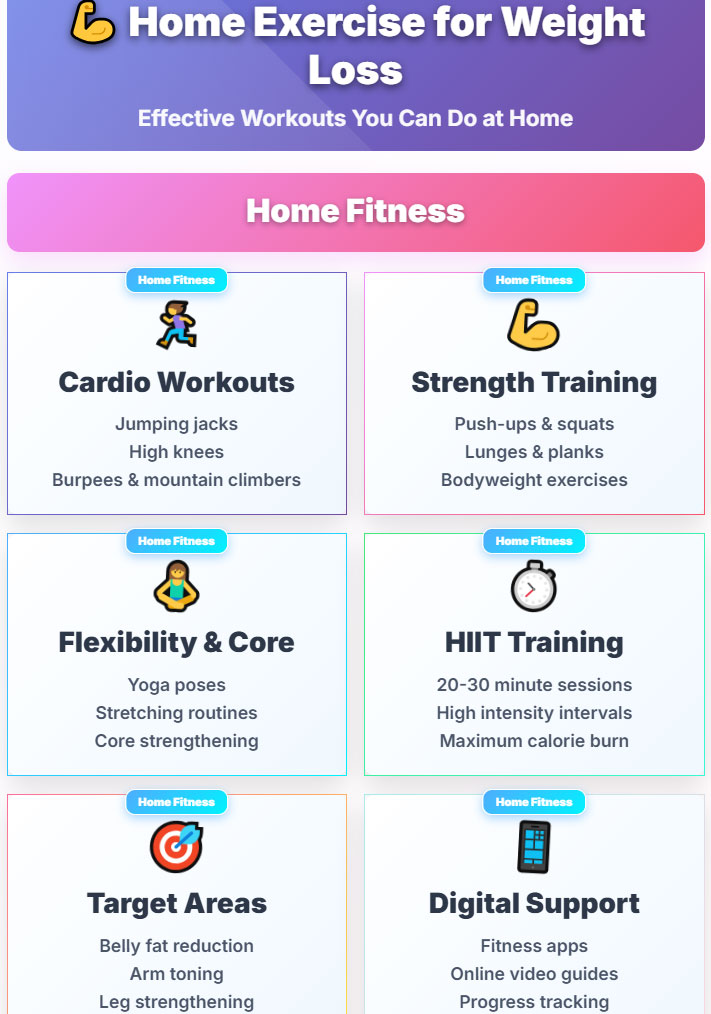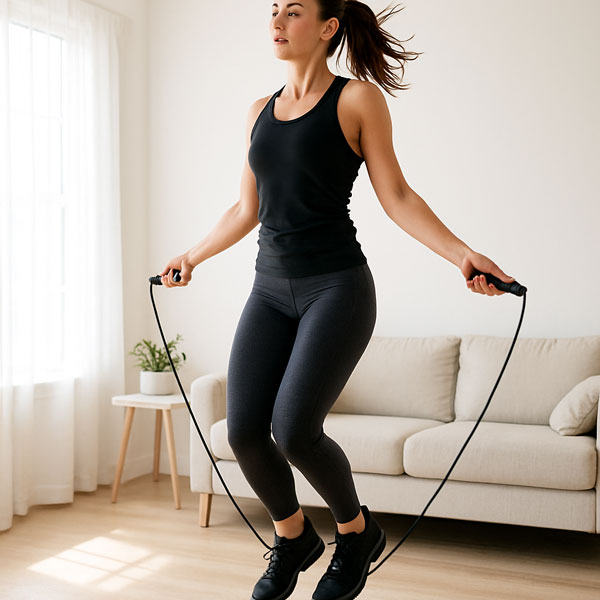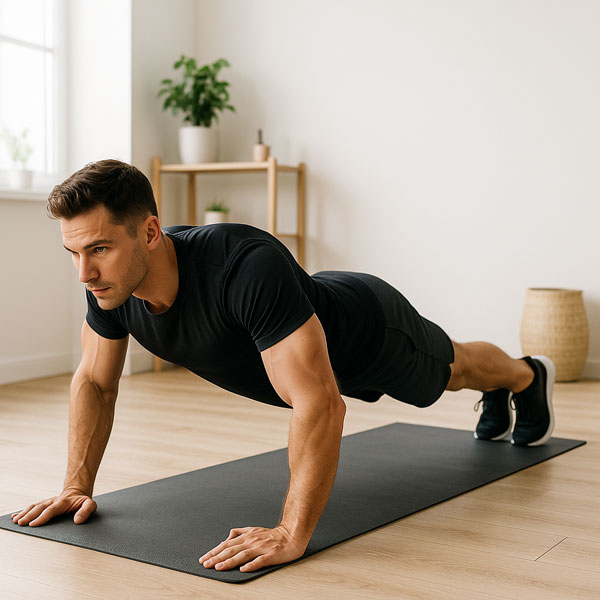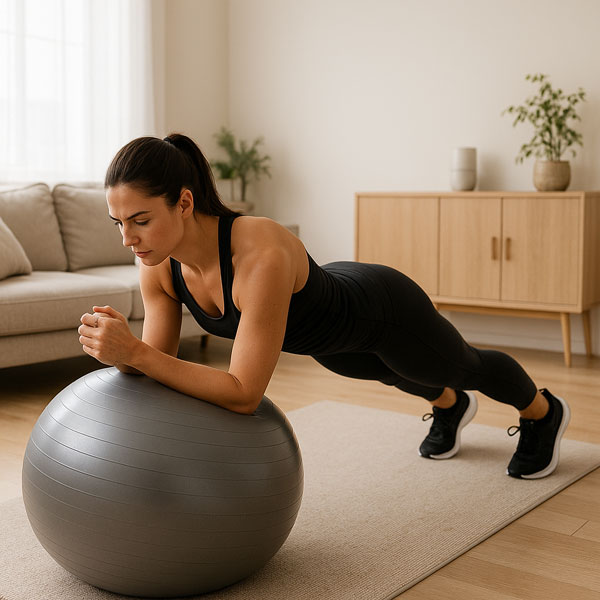In today’s fast paced world, home exercise has become more than just a practical choice it’s a strategic approach to weight loss. Without the need for costly memberships or travel time, you can focus directly on burning calories and building strength. Research shows that consistent home workouts can effectively reduce body fat when tailored to your fitness level. The convenience encourages regular training, which is key for measurable results. Whether performing body‑weight cardio, resistance moves, or high‑intensity intervals, home exercise gives you full control over your schedule and environment. Combined with discipline and proper technique, this method matches the efficacy of a gym. It’s about turning your living room into a results‑driven space for long‑term health and weight management.
what will you read…
Exercise and Diet in Weight Loss
Achieving weight loss is rarely about exercise alone or diet alone. it’s the synergy between the two that delivers lasting success. Exercise elevates your calorie burn, strengthens muscle mass, and boosts metabolism, while a well‑balanced diet regulates energy intake and improves nutrient quality. When combined, they create a sustainable calorie deficit without starving your body or overtraining. Cardiovascular workouts target fat oxidation, strength training preserves lean tissue, and nutrient‑dense meals fuel recovery and overall vitality. Canadian health guidelines emphasize pairing daily physical activity with mindful eating habits such as higher protein, adequate fibre, and limited processed sugars. This integrated approach ensures weight reduction, improved body composition, and better long‑term outcomes compared to relying on either component in isolation.
Understanding Types of Home Workouts
Home workouts come in many forms, offering flexibility for every fitness level. From simple body‑weight routines to structured high intensity sessions, the options are virtually limitless. What matters is choosing exercises that align with your goals whether that’s burning fat, improving endurance, or building strength. By mixing disciplines such as cardio, resistance moves, and core training, you can create a balanced program without leaving your home. Each category engages the body differently, keeping your metabolism active and preventing workout boredom. Thanks to modern guides and online resources, you can follow professional‑grade techniques with minimal equipment.
The key is variety, progression, and awareness of proper form, ensuring your living space becomes a safe yet challenging environment for effective weight loss and long‑term fitness.
Cardio Exercises
Cardio training is the engine of calorie burn in home workouts. Activities such as skipping rope, brisk marching in place, or dance‑based routines elevate your heart rate and stimulate fat metabolism. Consistency is crucial: performing 20 to 30 minutes of moderate to vigorous cardio most days keeps your body in a state of steady energy demand. These exercises improve cardiovascular health, lung capacity, and overall stamina while reducing visceral fat. The beauty of home cardio lies in its adaptability .you can train in short bursts or sustained sessions, adjusting intensity without specialized gear. Incorporating intervals or tempo changes prevents plateaus and maintains motivation.
Done regularly, cardio is the foundation of a high‑functioning metabolism and is a proven partner in sustainable weight loss.
Strength Training
Strength training in a home setting builds lean muscle, which in turn increases your resting metabolic rate. Movements like squats, lunges, push‑ups, and planks require minimal space and no expensive tools, yet produce significant physical changes. By challenging muscles with body weight or light resistance bands, you improve bone density, joint stability, and functional performance. A well structured routine typically includes 2 to 3 sessions weekly, focusing on all major muscle groups. Besides aesthetic benefits such as toned arms or a firmer core, strength work enhances postural control and injury prevention. For weight loss, its role is twofold:
boosting calorie expenditure during training and supporting a healthier metabolism after workouts. Combined with cardio, it creates a powerful formula for fat reduction and lifelong fitness.
High‑Intensity Interval Training
HIIT blends short, explosive exercise bursts with brief recovery periods, maximizing calorie burn in minimal time. In a home workout, moves like burpees, mountain climbers, or squat jumps push your heart rate to peak levels, then allow partial recovery before repeating. This method enhances cardiovascular fitness, muscle endurance, and metabolic efficiency far more rapidly than steady‑state exercise. Sessions can be as short as 15 minutes, making HIIT ideal for busy schedules. Research shows it increases post exercise oxygen consumption, meaning your body continues burning calories hours after you finish. Safety is essential proper warm up and gradual progression reduce injury risks.
Executed with discipline, HIIT is a top choice for home‑based fat loss, delivering intense results without requiring significant equipment or space.
Benefits of Sticking to a Regular Workout Plan
| Benefit | Description |
|---|---|
| Progress | Steady gains in fitness and weight control. |
| Habit | Makes exercise part of daily life. |
| Metabolism | Keeps calorie burn active. |
| Mood | Reduces stress, boosts energy. |
| Accessibility | Works anytime, anywhere. |
Consistency transforms workouts from occasional effort into an effective lifestyle. By maintaining a predictable schedule, the body adapts through increased strength, stamina, and metabolic efficiency. Regular exercise creates a habit loop that strengthens mental commitment and improves mood via endorphin release. Sticking with a plan also allows for measurable progress tracking repetitions, time, or weight encourages continued engagement. For weight loss, steady training maintains the calorie deficit needed for fat reduction and helps regulate appetite. In a home setting, routine removes external barriers like weather or commute, making fitness sustainable year‑round.
Coupled with proper nutrition, this consistency keeps energy high, reduces risk of chronic disease, and ensures that results, from a slimmer waistline to enhanced vitality, are both visible and lasting.
Guidelines Before Exercise
Preparation before exercise is the foundation of safe and effective training. Start with a proper warm‑up to activate muscles and prevent injury. Ensure your workout space is clean, spacious, and well‑lit. Gather and check all equipment in advance so nothing disrupts your flow. Wear comfortable, supportive clothing and shoes to boost performance. Finally, set a clear workout plan that matches your goals for maximum efficiency and results.

Steps to Take Before Your Home Workout
Warm Up Thoroughly
Before starting any workout, spend at least five minutes gradually increasing your heart rate. Gentle movements like marching in place, arm circles, or light jogging prepare muscles for higher intensity. This process boosts blood flow and joint lubrication, lowering the risk of strains or sprains. Warming up also activates the nervous system, improving coordination and response time. Think of it as priming your body’s “engine” for the demands ahead.
Choose the Right Space
Select a workout area that is clean, clutter‑free, and large enough for full range of motion. Avoid slippery surfaces or tight spaces where movement can be restricted. Adequate ventilation helps regulate body temperature and air quality. Good lighting ensures you maintain proper form and spot obstacles. Creating a designated exercise zone boosts focus and turns the space into a positive training environment.
Prepare Your Equipment
If your workout involves tools like resistance bands, dumbbells, or a yoga mat, ensure they are safe and in good condition. Keep water nearby for hydration during breaks. Arrange gear in a way that reduces interruptions between sets. Checking equipment beforehand prevents accidents caused by worn or unstable items. Ready‑to‑use tools save time and help you stay in a steady training rhythm.
Dress for Performance
Wear lightweight, breathable clothing that allows for free movement. Moisture‑wicking fabrics help keep sweat under control and skin comfortable. Supportive footwear is essential for avoiding foot, knee, or back injuries. Proper attire affects your agility, balance, and stamina, especially in longer sessions. When you feel physically comfortable, you can focus fully on technique and effort rather than distractions from your gear.
Set Your Workout Plan
Outline the exercises, sets, and timing before you start. Having a clear plan prevents inefficient training and ensures balanced muscle engagement. Structure your routine according to your fitness goal — fat loss, strength building, or endurance. Factor in rest intervals to maintain energy and avoid overtraining. A pre‑planned session boosts motivation and gives you measurable milestones for tracking progress over time.
Best Home Exercises for Weight Loss
Home workouts can deliver impressive weight loss results when planned with variety and consistency. Combining aerobic and strength training ensures calorie burn while building lean muscle mass. To boost recovery and muscle health, integrating massage techniques and, where possible, Kinesiotherapy targeted movement therapy helps improve flexibility, circulation, and posture. The key is to engage large muscle groups, keep the heart rate elevated, and maintain proper form. Without expensive gear, body‑weight movements and creative routines can match gym intensity. By pairing effective exercise with recovery methods, Canadians can accelerate fat reduction while preventing overuse injuries. Commitment is essential .three to five sessions per week, plus recovery care, keeps results on track.

Aerobic Routine without Equipment
Cardio training at home requires drive rather than dumbbells. Start with movements that raise the heart rate quickly and sustain it for 20 to 30 minutes. Jumping jacks, high knees, or speed walking on the spot activate major muscle groups and boost oxygen circulation. Space should be safe, with no obstructions, to allow full‑range motion. Keep pace steady but challenging to push the body into fat‑burning mode. Short rest intervals enhance calorie burn and stamina. With no gear needed, this routine suits beginners eager to lose weight or seasoned athletes maintaining fitness during busy weeks. Consistency turns each living room session into a high‑impact calorie torch without stepping out of the house.
Skipping Rope
Skipping rope remains a cost‑effective and powerful cardio option. Just ten minutes of consistent skipping can burn over 100 calories, depending on pace and body weight. It engages calves, quads, core muscles, and shoulders while sharpening coordination and agility. The exercise is adaptable: slow and steady for endurance, or fast bursts for high‑intensity intervals. Ropes are portable, fitting into any home environment, making it perfect for weight loss on tight schedules. Proper technique landing softly and keeping elbows close to the torso reduces joint stress. Over time, skipping rope boosts cardiovascular health, tones the lower body, and accelerates belly‑fat reduction when paired with clean eating.

Skater Step
The skater step mimics lateral skating motions, targeting thighs, hips, and core. It enhances balance and power through side to side lunges. Regular massage can loosen tight hip flexors after intense sets, while Kinesiotherapy guidance can refine range of motion for better muscle activation. This dynamic move raises heart rate, improving cardiovascular endurance. Keep your core tight and extend arms naturally for stability. Adjust intensity with speed or a small hop. Besides calorie burning, skater steps build agility, sculpt the waistline, and strengthen legs all enhanced when paired with proper recovery care.
Fast Burpees
Burpees are a full‑body calorie furnace. Starting from a standing position, you drop into a squat, kick back into a plank, perform a push‑up, then jump explosively upward. They engage chest, arms, core, quads, and glutes, delivering both strength and cardio benefits in one movement. Fast burpees amplify intensity, pushing the heart rate to fat‑burning zones quickly. Perfect for limited home spaces, they require zero equipment but maximum effort. Maintaining fluid transitions avoids wasted energy and supports injury prevention. Incorporating short bursts of burpees into workouts improves metabolic rate, enhances endurance, and drives rapid belly‑fat loss ideal for Canadians looking to merge efficiency and effectiveness in home training.
Strength Exercises for Body Shaping
Strength training at home sculpts the frame and boosts metabolism long after the workout ends. Using body weight or household items, you can challenge every muscle group. Squats, lunges, push‑ups, and planks form the foundation for toning arms, legs, and core. Prioritizing correct form ensures targeted muscle activation and reduces risk of strain. These exercises improve posture, joint health, and bone density vital for sustainable weight loss. Alternating muscle groups from session to session prevents overtraining and maintains progress. Strength moves combined with cardio speed up fat reduction while defining muscles, creating a lean and functional physique without stepping into a gym.
Squat
The squat is the king of full‑body strength moves. It demands activity from quads, hamstrings, glutes, and core simultaneously. Performing deep squats with controlled movement builds power in the lower body and improves balance. In home settings, squats require no equipment but deliver layered benefits: calorie burn, muscle endurance, and joint stability. Keep feet shoulder‑width apart, chest lifted, and knees tracking over toes for optimal safety. Squats enhance metabolism, supporting weight loss even at rest. Variations like sumo or pulse squats add challenge and maintain engagement. Consistent inclusion in routines helps reshape legs and glutes while bolstering overall body strength.
Walking Lunge
Walking lunges combine muscle sculpting with functional mobility. They engage quads, glutes, hamstrings, and calves while also demanding core stability. Executing lunges across a small space still improves stride length and balance. Focus on slow, deliberate form step forward, bend both knees to 90 degrees, and push off the front heel. This movement strengthens each leg equally, addresses muscle imbalances, and aids injury prevention. Lunges burn calories through sustained muscle activation, making them useful for maintaining weight loss momentum. Adding light dumbbells or water bottles increases resistance. Walking lunges contribute to a toned lower body and improved everyday movement patterns.
Push Up and Plank
Push‑ups and planks are foundation moves for upper body strength and core stability. Push‑ups train chest, shoulders, triceps, and core muscles while elevating heart rate for added calorie burn. Planks target deep abdominal muscles, improving posture and functional strength. At home, these exercises need only floor space and a mat. Form is crucial: keep a straight line from head to heels in both movements. Variations such as decline push‑ups or side planks add progression while keeping sessions fresh. Together, they enhance endurance, tone the torso, and play a vital role in reducing belly and waist fat within balanced workout routines.

Combined Workouts for Maximum Fat Burning
Blending aerobic and strength exercises accelerates fat loss while improving overall fitness. An effective home circuit might include skipping rope for two minutes, ten push‑ups, twenty squats, and ten fast burpees repeated three to five times. This method keeps heart rate high while engaging multiple muscle groups. Alternating movements avoids monotony and maximizes caloric expenditure. High‑intensity interval training (HIIT) principles fit perfectly here, offering results in shorter sessions. The combination builds endurance, tones muscles, and improves metabolic efficiency long after the workout ends. For Canadians balancing busy schedules, combined routines deliver substantial weight loss and body shaping without leaving home.
Specialized Exercises for Waist Slimming
Reducing belly and waist fat requires a combination of targeted core exercises and consistent aerobic activity. These workouts strengthen the deep abdominal muscles, helping to improve posture and create a slimmer profile. Focus on movements that activate multiple muscle groups, such as planks, twists, and controlled leg lifts. Proper nutrition is essential for accelerating results, but exercise remains the driving force for tone and definition in these areas. Recovery strategies like stretching and self‑massage help keep muscles flexible and prevent injury, ensuring continuity in training. By following a structured plan three to five times a week, anyone can achieve noticeable changes in waistline shape and overall core strength.
Plank and Its Variations
Plank exercises are a cornerstone for core engagement, challenging the abdomen, back, and shoulders at once. The standard forearm plank trains stability, while side planks target obliques for waist reduction. Adding movement, such as plank jacks or shoulder taps, raises the heart rate and burns extra calories. Planks require nothing more than a flat surface, making them ideal for home workouts. Form is crucial: keep a straight line from head to heels and engage the core throughout. Over time, regular planking builds endurance, improves spinal support, and sculpts the midsection. Changing angles and durations keeps sessions effective and prevents performance plateaus.

Static Crunch and Bicycle Crunch
Static crunch holds isolate and strengthen the upper abs by maintaining a fixed contraction. Bicycle crunches combine rotation with leg movement, engaging both upper and lower abs along with obliques. This blend improves muscle tone and promotes calorie burn through sustained activity. Performing these exercises on a mat ensures comfort and proper alignment. Controlled movements prevent neck strain and promote precise engagement of the target muscles. Consistent practice, two to three sets at moderate intensity, yields visible waistline shaping within weeks. Mixing static and dynamic styles adds variety and keeps the muscles adapting for better fat reduction results.
Russian Twist and Leg Raise
Russian twists focus on oblique strength by rotating the torso side to side, enhancing waist definition. Leg raises work the lower abdominal region, demanding balance and control from the core. Combining both creates a powerful routine for flattening the stomach and tightening the waistline. Slow, precise movements ensure the muscles are doing the work rather than momentum. A small weight or household item can add intensity to the Russian twist, while keeping legs straight in raises challenges endurance. Regular training improves abdominal strength, stability, and appearance, making these exercises a reliable choice for home‑based fat reduction programs.
Lifestyle Habits to Complement Home Workouts
| Habit | Benefit |
|---|---|
| 7–8 hours sleep | Improves recovery and energy levels |
| Balanced nutrition | Fuels muscles, supports weight loss |
| Stay hydrated | Enhances metabolism and endurance |
| Manage stress | Keeps hormones stable for fat reduction |
| Daily light activity | Adds calorie burn and joint flexibility |
Home exercise delivers results, but lifestyle choices determine how long those benefits last. Adequate sleep allows muscles to repair, boosting strength and performance. Balanced meals with lean protein, whole grains, and fresh vegetables fuel workouts while aiding fat reduction. Hydration supports energy levels and metabolic function throughout the day. Managing stress prevents hormonal imbalances that can slow weight loss, making relaxation techniques like deep breathing essential. Light activity outside formal workouts walking, stretching, or household chores maintains calorie burn and keeps joints mobile. Combining home training with smart daily habits turns short‑term gains into sustained health improvements and lasting energy.
Home Exercise for Weight Loss – FAQs
Do I need expensive equipment for effective home workouts?
No. Bodyweight exercises like squats, push‑ups, planks, and skipping rope can be highly effective without any costly equipment.
How long will it take to see results?
It depends on your starting point, workout intensity, and diet. Most people notice changes in energy, strength, and body shape within 4‑8 weeks.
Is doing only cardio enough for weight loss?
Cardio helps burn calories quickly, but combining it with strength training boosts metabolism and tones muscles for longer‑term results.
